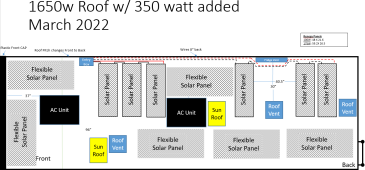RoadTurtle
Solar Enthusiast
- Joined
- Mar 30, 2022
- Messages
- 368
I can get three 200w panels on each side of the RV, for a total of six panels.
Plan is wire 2S 3P. Shading from junk on the centerline is a problem depending on trailer orientation. It will get worse with adding these panels.
Should the panels in series be on either side of the the centerline (2 front, 2 middle, and 2 rear), or on the same side (front and center left, front and center right, two rear), or something else? Worst one of the bunch is right rear, as it's going be tight up against the full size AC.
Plan is wire 2S 3P. Shading from junk on the centerline is a problem depending on trailer orientation. It will get worse with adding these panels.
Should the panels in series be on either side of the the centerline (2 front, 2 middle, and 2 rear), or on the same side (front and center left, front and center right, two rear), or something else? Worst one of the bunch is right rear, as it's going be tight up against the full size AC.




